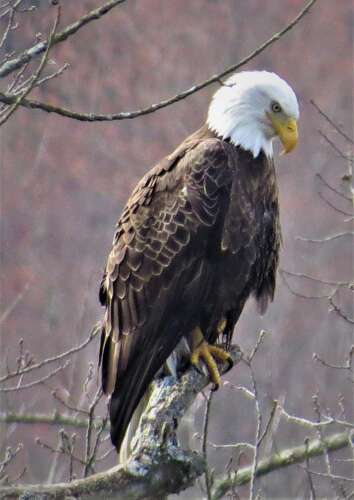Published October 31. 2020 07:47AM
If you read my column regularly, you know my extreme interest in birds. I try to get outdoors as much as often as I can, maybe to get a new bird for my annual bird list, or looking to find one I’ve never seen before to add to my “life list.”
I enjoy most of the birds’ beauty, but none give me the “rush” each time I see it, like the bald eagle. Each one I see still impresses me. If I’m riding the garden tractor, working in my orchard, or fly fishing a local trout stream, my eyes are almost always skyward. I probably have about three or four eagle sightings each week.
The bald eagle is our national symbol. That wasn’t Ben Franklin’s choice. He felt it was a thief and wanted the wild turkey. Well, he was correct. Eagles are opportunistic, and if an osprey catches a fish, a bald eagle will often “hound it” and usually forces it to drop its meal.
A few weeks ago we made a quick trip to Cape May in the heart of osprey migration time. In two days I watched two separate dramas of just what I explained. In one instance, the osprey dropped the fish and the eagle swooped into the pond and snatched it up. But, that is nature.
Bald eagles reach about 36 inches in length, weigh about 12-15 pounds, and have a 6½ foot wingspan. In flight their wings are held straight out, unlike the common turkey vulture whose wings are held in a slight “v” pattern. Eagles mature at 5 years of age and attain the white head and tail then. Female eagles are slightly larger than the males.
My timing for this column was to coincide with the beginning of nest building/remodeling. They almost always use the previous year’s nest by adding more sticks and branches. Eagles pair up for life and except for egg-laying, share in the duties of incubation, guarding the nest and feeding the young. I believe the female has the final say (sound familiar) with the nest construction. While watching a live feed of an eagle nest last year, the male brought to the nest a 6-foot branch and apparently placed it at the wrong spot. After a beak shaking and aggressive posture, the female grabbed the limb and put it where she thought to be best. It was comical. Since they add materials each year, the nests can be 6 feet or more in size and depth. They can get very heavy as well.
Generally the nest is placed high in a sturdy fork of a large pine or open limbed tree. While watching the nests last year on live feed, all three females, in three different parts of the state, laid their first egg on Feb. 13. (Eggs are generally laid every other day, and two is generally the norm.)
If three eggs are laid, the first hatching chick will be about four days older than the last to hatch. They hatch in about 35 days. The parents have to be aware of the larger, hungrier chick and ensure that the smaller ones get their share of food. The eaglets remain in the nest over 70 days. Even after fledging, they often remain close by, still relying on the adults to feed them.
The Pennsylvania Game Commission reported over 300 nests in the state this year. Quite an amazing story considering that in 1983 there were only three. I know of four eagle nests in the Times News region and have been trying to pinpoint the location of a fifth. Most of the nests are rather close to water since for most bald eagles, fish is their chief food source. However, the Hanover eagle pair (York County) were bringing rabbits, woodchucks and domestic fowl to their young. Closer to the February egg laying I’ll supply you with some sites to follow the live video feeds. Eagle watching or not, get out there.
Test Your Outdoor Knowledge: A bald eagle nest is called a(n) ____. A. aerie, B. calyx, C. corona, D. pinnacle.
Last Week’s Trivia Answer: Surprisingly, the Carolina wren, not the winter wren, is most likely to remain in our area all winter.
Contact Barry Reed at breed71@gmail.com.
An adult bald eagle scans the Pohopoco Creek, waiting for the opportunity to catch an unsuspecting fish. BARRY REED/SPECIAL TO THE TIMES NEWS
With her eaglets awaiting their turn, a bald eagle begins to feed them some of the prey he/she brought to the nest.
A 2-year-old bald eagle perched over Lizard Creek.
The second-year bald eagle shows white feathers scattered on the body and a bill showing almost no yellow.
An osprey, seen perched, can display a mostly white head vaguely resembling a bald eagle. But in flight, the white belly and narrower wings are a “giveaway.”
A juvenile eagle in its nest displays the plain deep chocolate-brown feathers it will carry until age 2.
This immature bald eagle is probably nearing its 3-year plumage (some white beginning to appear on its head).
Always majestic, this adult bald eagle regally sits on a perch over Wild Creek in Penn Forest Township.
Credit: Source link































